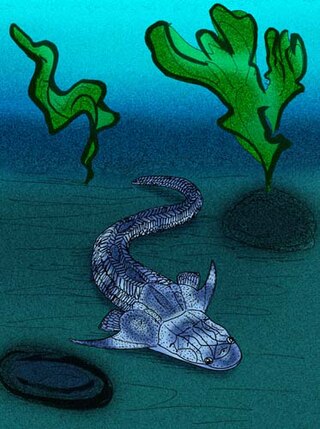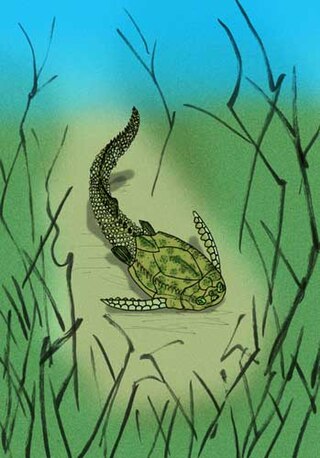
Placodermi is a class of armoured prehistoric fish, known from fossils, which lived from the Silurian to the end of the Devonian period. Their head and thorax were covered by articulated armoured plates and the rest of the body was scaled or naked, depending on the species. Placoderms were among the first jawed fish; their jaws likely evolved from the first of their gill arches.

Dunkleosteus is an extinct genus of large arthrodire fish that existed during the Late Devonian period, about 382–358 million years ago. It consists of ten species, some of which are among the largest placoderms to have ever lived: D. terrelli, D. belgicus, D. denisoni, D. marsaisi, D. magnificus, D. missouriensis, D. newberryi, D. amblyodoratus, and D. raveri. The largest and most well known species is D. terrelli, which grew up to 8.79 m (28.8 ft) long and 4 t in weight. Dunkleosteus could quickly open and close its jaw, like modern-day suction feeders, and had a bite force of 4,414 N at the tip and 5,363 N at the blade edge. Numerous fossils of the various species have been found in North America, Poland, Belgium, and Morocco. Dunkleosteus is believed to have been a pelagic animal.

Petalichthyida is an extinct order of small, flattened placoderm fish. They are typified by their splayed pectoral fins, exaggerated lateral spines, flattened bodies, and numerous tubercles that decorated all of the plates and scales of their armor. They reached a peak in diversity during the Early Devonian and were found throughout the world, particularly in Europe, North America, Asia, South America, and Australia. The petalichthids Lunaspis and Wijdeaspis are among the best known. The earliest and most primitive known petalichthyid is Diandongpetalichthys, which is from earliest Devonian-aged strata of Yunnan. The presence of Diandongpetalichthys, along with other primitive petalichthyids including Neopetalichthys and Quasipetalichthys, and more advanced petalichthyids, suggest that the order may have arisen in China, possibly during the late Silurian.

Rhenanida is an order of scaly placoderms. Unlike most other placoderms, the rhenanids' armor was made up of a mosaic of unfused scales and tubercles. The patterns and components of this "mosaic" correspond to the plates of armor in other, more advanced placoderms, suggesting that the ancestral placoderm had armor made of unfused components, as well.

Antiarchi is an order of heavily armored placoderms. The antiarchs form the second-most successful group of placoderms after the arthrodires in terms of numbers of species and range of environments. The order's name was coined by Edward Drinker Cope, who, when examining some fossils that he thought were armored tunicates related to Chelysoma, mistakenly thought that the orbital fenestra was the opening for the mouth, or oral siphon, and that the opening for the anal siphon was on the other side of the body, as opposed to having both oral and anal siphons together at one end.
Kenichthys is a genus of sarcopterygian fish from the Devonian period, and a member of the clade tetrapodomorpha. The only known species of the genus is Kenichthys campbelli, the first remains of which were found in China in 1993. The genus is important to the study of the evolution of tetrapods due to the unique nature of its nostrils, which provide vital evidence regarding the evolutionary transition of fish-like nostrils to the tetrapod choanae.

Youngolepis is a genus of prehistoric lobe-finned fish which lived during the Early Devonian period. Fossils of Y. praecursor have been found in the Xitun Formation of China & the Bac Bun Formation of Trang Xa, Vietnam. Some additional fossil specimens from the Xishancun Formation of China have been referred to Youngolepis sp. & represent the oldest known occurrence of the genus.

Minicrania is an extinct genus of tiny antiarch fish, with armor averaging up to about 2 centimetres (0.79 in) long, which lived during the Lochkovian epoch in Early Devonian Yunnan Province, China and northern Vietnam.
Gavinaspis is a phyllolepid placoderm which lived during the Early Devonian period, of Qujing, Yunnan province, south China.
The Xitun Formation is a palaeontological formation which is named after Xitun village in Qujing, a location in South China. This formation includes many remains of fossilized fish and plants of the Early Devonian period. It was originally referred to as the Xitun Member of the Cuifengshan Formation.

Quasipetalichthys haikouensis is the type and only known species of the extinct petalichthid placoderm, Quasipetalichthys. Fossil remains of Quasipetalichthys have been found in the Middle Devonian, Givetian faunal stage of China.

Nochelaspis is an extinct genus of Galeaspid. It lived during the Lochkovian period in Lower Devonian East Asia.

Guiyu oneiros is the earliest articulated bony fish discovered. The generic name Guiyu is a transliteration of the Mandarin 鬼魚 guǐyú "ghost fish" and the specific name oneiros is from Greek ὄνειρος "dream". Fossils of Guiyu have been found in what is now Qujing, Yunnan, China, in a late Silurian marine strata, about 425 million years old. Guiyu remains have been found articulated, missing only the caudal fin. The living fish is estimated to have been around 30 cm long.

Silurolepis platydorsalis is an extinct species of Silurian-aged "maxillate" placoderm that has been described from (mostly) articulated remains. Although it has been known for several years, it was finally described by Zhang, et al., in 2010. The earliest described placoderm is the yunnanolepid antiarch, Shimenolepis, from Llandovery Hunan. In contrast to S. platydorsalis, Shimenolepis is known only from distinctively ornamented thoracic armor plates that bear anatomic features unique to yunnanolepids.

Diandongpetalichthys liaojiaoshanensis is an extinct petalichthid placoderm from the Early Devonian of China.

Parayunnanolepis xitunensis is an extinct, primitive antiarch placoderm. The fossil specimens, including a marvelously preserved, intact specimen, are known from the Lochkovian Epoch-aged Xitun Formation of Early Devonian Yunnan. The armor is very similar to that of Yunnanolepis, but is distinguished by being comparatively more flattened.

Vukhuclepis lyhoaensis is an extinct, primitive antiarch placoderm. Specimens are of mostly complete thoracic armor from the Early Devonian Ly Hoa Formation in Vietnam. The armor is very similar to that of Yunnanolepis, but is distinguished by a unique pattern of raised ridges radiating from a point at the center of the dorsal shield of the thoracic armor. A similar, albeit more floral-looking pattern is seen in the Chinese Mizia. V. lyhaoensis' armor is further ornamented with small tubercles.
Microbrachius is an extinct genus of tiny, advanced antiarch placoderms closely related to the bothriolepids. Complete articulated specimens show that the armored section of the body had an average length of 2-4 cm. Species of Microbrachius are characterized by having large heads with short thoracic armor. Specimens of Microbrachius have been found in Scotland, Belarus, Estonia, and China. Specimens range in age from the Lower Devonian Late Emsian Stage to the Middle Devonian Upper Givetian Stage.

Megamastax is a genus of lobe-finned fish which lived during the late Silurian period, about 423 million years ago, in China. Before the discovery of Megamastax, it was thought that jawed vertebrates (gnathostomes) were limited in size and variation before the Devonian period. Megamastax is known only from jaw bones and it is estimated that it reached about 1 metre long.

Wufengshania is an extinct genus of bothriolepidid placoderm from the Emsian epoch of China. The type species, Wufengshania magniforaminiswas named by Zhaohui Pan et al., 2018.

















